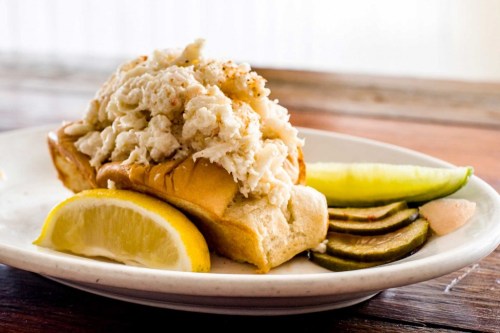I was thrilled when the food writing goddess Molly O’Neill recently called this “a terrific piece looking at the intersection of food, real estate, life and the commodification of the modern, the local, the sustainable and the imaginative by the wonderful Donna Minkowitz.” It was published in Gay City News on June 9, 2016.
Under normal circumstances, my reaction to the news that a new artisanal food hall had opened in the city might be rage. In the extraordinarily beautiful river park next to Battery Park City, new kids in town Le District and Hudson Eats are revoltingly overpriced and offensively underwhelming. ($15 for bad, small “Skinny Pizza”? $12.50 for a teeny bagel with a tiny bit of beet-cured lox at Black Seed?) And they replaced the perfectly good, cheaper eats you used to be able to enjoy in that complex (Brookfield Place), while looking out at the the shimmery Hudson and listening to interesting free music and performance art.
I like the food at Brooklyn Flea, but its bigger offspring, Smorgasburg, is too crowded to enjoy, with diners competing madly for savviest-foodie-hipster status and for a sadistically small number of seats. (As with David Chang’s deliberately painful seating at his Momofuko restaurants, upscale food promoters are trying to train diners to accept ever-smaller and more uncomfortable spaces as the value per foot of city real estate goes ever up.)
Marcuse coined the phrase “repressive desublimation” to mean the pleasures that consumer culture promises you, only to have the supposed ecstasies of the Berkshire pork taco (say) vanish as soon as you take the first bite. Pleasures fade exactly this quickly at the Gotham West Market, The Plaza Food Hall, Chelsea Market — all the carnivals of fake-bacchanalian fressing. It’s easy (if you’re not poor, that is) to be swept away with excitement by the sight of all that quivering, umami, gleaming, exciting food. Smoked whitefish with rice from Ivan Ramen! Hibiscus doughnuts from Dough! Popsicles made from cherry blossoms! Wow! But when you finally eat them, the revolutionary pleasures they seemed to offer are compressed out of all existence by the crowded, uncomfortable, competitive space, the lackluster culinary skills of the preparers, and the pressures of doing what is in effect the unpaid job of Instagraming, tweeting, and blogging about the hyped-up food you just ate. In an age when it’s mandatory to have social media profiles and to build your personal status by any means necessary, we pay once for the artisanal grub and then a second time, by promoting it for free.
There’s more. Alyssa Katz, an editorial writer for the New York Daily News who has covered real estate for decades, says luxury developers are using the upscale food halls and festivals to escalate gentrification in their neighborhoods. “There’s been a very deliberate investment by these developers” in yuppie food hubs, she says, for the express purpose of luring high-income tenants and buyers. In fact, Smorgasburg owners Jonathan Butler and Eric Demby say they were invited to set up shop on the Williamsburg waterfront by real-estate developers who “were trying to sell [apartments in] their buildings.” And Uprose, Sunset Park’s anti-gentrification group, has sharply criticized Industry City, the “disruption hub” in Sunset Park whose food hall (including a Smorgasburg) is spurring yuppie relocation that will lead to the displacement of thousands of low-income Sunset Parkers.
Which brings me to the city’s newest food hall, The Pennsy. It’s a yuppie gastro-hub that has somehow opened on top of Penn Station, which could be described as the stinking asshole of New York City. In that benighted neighborhood, the brain-killing giant neon billboards make you want to die even more than the ugly, dark, and dirty confines of Penn Station underneath. In the station, of course, there is no food that could even be called tolerable, stranding the 600,000 who enter it daily to use Amtrak, the LIRR, and New Jersey Transit. Continue reading “The Revolution Will Not Be Consumed at Smorgasburg”








